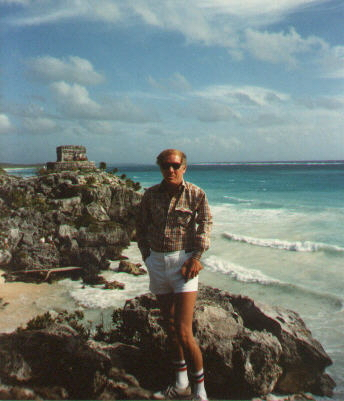Tulum
Here
Jon
is along the Atlantic coast and in front of
Tulum, one of the few
Mayan ruins situated on the cliffs overlooking the ocean.
Tulum means fence, trench or wall, and is the name given to the site in recent times because of the wall surrounding it, although its ancient name was possibly
 Zama, a corruption of Zamal (morning), associated with the dawn. This is an ideal name for the site, as sunrise in Tulumis a superb sight.
The first mention of this city was made by Juan Diaz, who was on Juan de Grijalva's expedition that reached the coast of the Yucatan peninsula in 1518. He wrote, "We followed the coast day and night; on the following day... we sighted a city or town so large that Seville would not have appeared bigger or better... a very tall tower was to be seen there..." which no doubt refers to Tulum and the building known as the Castle, standing on the edge of the cliff.
Zama, a corruption of Zamal (morning), associated with the dawn. This is an ideal name for the site, as sunrise in Tulumis a superb sight.
The first mention of this city was made by Juan Diaz, who was on Juan de Grijalva's expedition that reached the coast of the Yucatan peninsula in 1518. He wrote, "We followed the coast day and night; on the following day... we sighted a city or town so large that Seville would not have appeared bigger or better... a very tall tower was to be seen there..." which no doubt refers to Tulum and the building known as the Castle, standing on the edge of the cliff.
In Juan de Reigosa's Las Relaciones de Yucatan, written in 1579, Zama is mentioned as a walled site with stone buildings which included a very large one that looked like a fortress. Pedro Sanchez de Aguilar, author of Informe Contra Idolorum Cultores del Obispado de Yucatan, (Madrid, 1639) mentions the coast of Zama when telling the story of ten shipwrecked Spaniards who were taken prisoner by the chieftain Kenich. Among them was Geronimo de Aguilar, who later became Hernan Cortes' interpreter during the Conquest of Mexico.
After this there are no other references to Tulum until Juan Pio Perez in a letter dated 1840 says that Juan Jose Galvez had visited Ascencion Bay, discovering that between there and Cape Catoche there were two ancient cities, Tancah and Tulum, the latter surrounded by walls.
In 1842, John L. Stephens and Frederick Catherwood visited tho site and later made it known to the world with the book Incidents of Travel in Yucatan, where Stephen's text is complemented by Catherwood's magnificent illustrations. During the Maya uprising of the War for the Castes, which began in 1847 and lasted until 1901, Tulum was occupied several times by rebels because of the protection its wall afforded. In 1871 it became one of the sanctuaries of the "Speaking Cross" cult, led by the Indian woman Maria Uicab, who was known as the patron saint or queen of
Tulumn.
Several expeditions reached Tulum later. In 1895, W. H. Holmes made two drawings of the area from his yacht, and in 1913 Sylvanus G. Morley and J.L. Nussbaum paid a short visit to the site.
The Carnegie Institution of Washington organized expeditions in 1916, 1918 and 1922 led by Morley and including other noted researchers. In 1937, members of the Mexican Scientific Expedition studied various sites on the east coast of the Yucatan peninsula, including Tulum. The following year Miguel Angel Fernandez began the work of restoring and in investigating the site. Finally, the National Institute of Anthropology and History, through the Southeast Regional Center is continuing investigation and maintenance of this important Maya archaeological site.
Return to the Mexico Home Page
 Zama, a corruption of Zamal (morning), associated with the dawn. This is an ideal name for the site, as sunrise in Tulumis a superb sight.
The first mention of this city was made by Juan Diaz, who was on Juan de Grijalva's expedition that reached the coast of the Yucatan peninsula in 1518. He wrote, "We followed the coast day and night; on the following day... we sighted a city or town so large that Seville would not have appeared bigger or better... a very tall tower was to be seen there..." which no doubt refers to Tulum and the building known as the Castle, standing on the edge of the cliff.
Zama, a corruption of Zamal (morning), associated with the dawn. This is an ideal name for the site, as sunrise in Tulumis a superb sight.
The first mention of this city was made by Juan Diaz, who was on Juan de Grijalva's expedition that reached the coast of the Yucatan peninsula in 1518. He wrote, "We followed the coast day and night; on the following day... we sighted a city or town so large that Seville would not have appeared bigger or better... a very tall tower was to be seen there..." which no doubt refers to Tulum and the building known as the Castle, standing on the edge of the cliff.